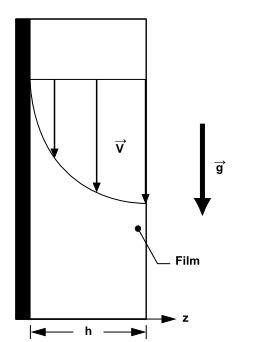Equation 17–2 is used to obtain film average velocity through momentum conservation. However, one can estimate the film velocity without solving Equation 17–2. In this case, the film velocity is assumed to have a component that is driven by the shear due to the external flow and a component that is driven by gravity.
As shown in Figure 17.3: Shear-Driven Film Velocity, it is assumed that the film velocity varies linearly from the wall to the air-film interface.
By equating the two shear forces at the film-air interface, one from the air side and one from the film side, we have,
(17–31) |
where is
the surface velocity. The film average velocity is therefore,
(17–32) |
It is assumed that the film movement is entirely controlled by the balance of gravity force and the wall shear force, and that the film velocity has a parabolic profile with a zero-gradient at the air-film interface, as shown in Figure 17.4: Gravity-Driven Film Velocity.
Assuming no-slip at the wall, the parabolic film velocity becomes .
Balancing the weight of the film and the wall shear force, we have,
(17–33) |
therefore,
(17–34) |
Applying the zero-gradient assumption at the air-film interface, we have,
(17–35) |
Thus the gravity-induced film velocity is,
(17–36) |
The film average velocity is,
(17–37) |




